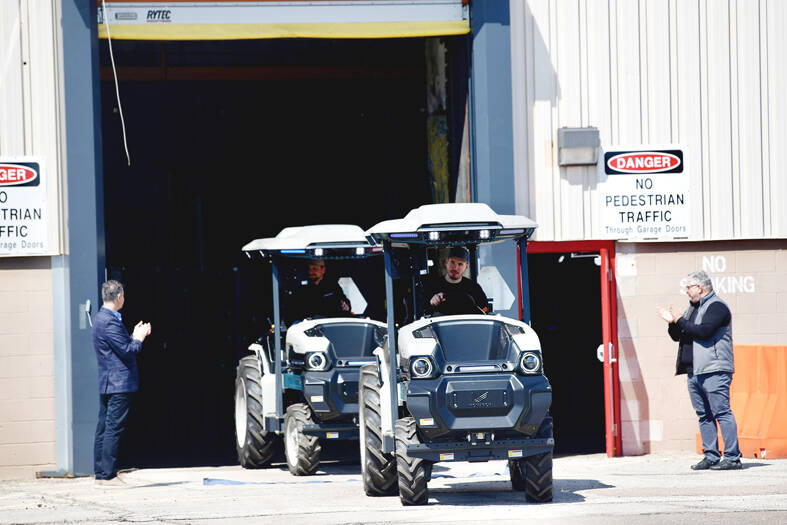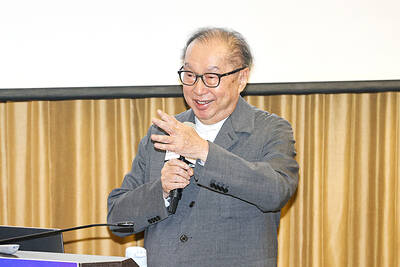Hon Hai Precision Industry Co (鴻海精密) yesterday reported that revenue last month edged down 0.43 percent month-on-month to NT$400.29 billion (US$13.14 billion), the lowest since August 2021’s NT$400.05 billion.
On an annual basis, revenue dropped 21.11 percent, the company, also known as Foxconn Technology Group (富士康科技集團) globally, said in a statement.
However, it was the third-best March performance in the firm’s history, the iPhone assembler said.

Photo courtesy of Hon Hai Precision Industry Co
March last year was the highest for the same period, with NT$507.39 billion in revenue, followed by NT$441.22 billion in March 2021, it said.
Hon Hai said its consolidated revenue in the first three months of the year rose 3.87 percent to NT$1.46 trillion, a record for the first quarter, but was down 25.26 percent from the previous quarter.
That is higher than Fubon Securities Investment Services Co’s (富邦投顧) estimates of a 2 percent annual increase to NT$1.43 trillion and met the firm’s guidance on March 15, when it said first-quarter revenue would receive a boost from the production ramp-up at its Zhengzhou facilities in China.
The world’s biggest contract electronics maker attributed the first-quarter increase to a sharp improvement in its consumer electronics segment, as its production lines in Zhengzhou — Apple Inc’s key manufacturing hub in China — had returned to normal in January, following disruptions from a COVID-19 outbreak late last year.
That helped offset a relatively flat performance in its cloud and networking technology segment, as well as lower sales of computing products and components due to weak PC market demand and slowing pull-in orders from customers, Hon Hai said.
However, the firm is cautious about the outlook for the second quarter, saying that revenue would decrease annually and quarterly as the industry undergoes a product transition and because of a relatively high comparison base last year.
While the contribution from its electric vehicle business remains low, Hon Hai yesterday announced the start of production of the electric Monarch MK-V tractors at its Ohio factory, with the initial five tractors rolling off the production line for delivery to customers.
The MK-V is a fully electric, driver-optional, smart tractor that combines electrification, automation and data analysis to help farmers reduce their carbon footprint, while increasing their profitability, the company said in a separate statement.
Separately, smartphone camera lens maker Largan Precision Co (大立光) yesterday reported that consolidated revenue last month rose 28.98 percent month-on-month, but fell 11.91 percent year-on-year to NT$3.31 billion.
The figure is largely in line with the company’s guidance and brings its first-quarter revenue to NT$9.14 billion, down 9.84 percent from a year earlier. It was also higher than the NT$8.72 billion forecast by Capital Investment Management Corp (群益投顧).
Largan, a technological leader in the handset camera lens industry, said in a statement that high-margin 20-megapixel or more lenses for smartphone cameras accounted for 20 to 30 percent of its total sales last month.
The majority, or 60 to 70 percent, came from sales of 10-megapixel lenses, while 8-megapixel lenses contributed less than 10 percent, it said.
With consumer demand for smartphones remaining weak, inventory adjustments in the handset supply chain continuing and the Chinese economy still sluggish, Largan said sales this month would be lower than last month.

BYPASSING CHINA TARIFFS: In the first five months of this year, Foxconn sent US$4.4bn of iPhones to the US from India, compared with US$3.7bn in the whole of last year Nearly all the iPhones exported by Foxconn Technology Group (富士康科技集團) from India went to the US between March and last month, customs data showed, far above last year’s average of 50 percent and a clear sign of Apple Inc’s efforts to bypass high US tariffs imposed on China. The numbers, being reported by Reuters for the first time, show that Apple has realigned its India exports to almost exclusively serve the US market, when previously the devices were more widely distributed to nations including the Netherlands and the Czech Republic. During March to last month, Foxconn, known as Hon Hai Precision Industry

Taiwan Semiconductor Manufacturing Co (TSMC, 台積電) and the University of Tokyo (UTokyo) yesterday announced the launch of the TSMC-UTokyo Lab to promote advanced semiconductor research, education and talent development. The lab is TSMC’s first laboratory collaboration with a university outside Taiwan, the company said in a statement. The lab would leverage “the extensive knowledge, experience, and creativity” of both institutions, the company said. It is located in the Asano Section of UTokyo’s Hongo, Tokyo, campus and would be managed by UTokyo faculty, guided by directors from UTokyo and TSMC, the company said. TSMC began working with UTokyo in 2019, resulting in 21 research projects,

Ashton Hall’s morning routine involves dunking his head in iced Saratoga Spring Water. For the company that sells the bottled water — Hall’s brand of choice for drinking, brushing his teeth and submerging himself — that is fantastic news. “We’re so thankful to this incredible fitness influencer called Ashton Hall,” Saratoga owner Primo Brands Corp’s CEO Robbert Rietbroek said on an earnings call after Hall’s morning routine video went viral. “He really helped put our brand on the map.” Primo Brands, which was not affiliated with Hall when he made his video, is among the increasing number of companies benefiting from influencer

Quanta Computer Inc (廣達) chairman Barry Lam (林百里) yesterday expressed a downbeat view about the prospects of humanoid robots, given high manufacturing costs and a lack of target customers. Despite rising demand and high expectations for humanoid robots, high research-and-development costs and uncertain profitability remain major concerns, Lam told reporters following the company’s annual shareholders’ meeting in Taoyuan. “Since it seems a bit unworthy to use such high-cost robots to do household chores, I believe robots designed for specific purposes would be more valuable and present a better business opportunity,” Lam said Instead of investing in humanoid robots, Quanta has opted to invest